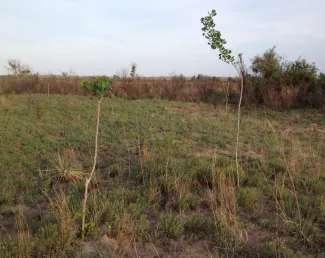Eastern cottonwood (Populus deltoides) is an important tree for wildlife, especially in western Oklahoma along draws and riparian areas. This tree has been disappearing due to drought, fragmented landscapes, and eastern redcedar (Juniperus virginiana) encroachment. These impacts have limited the regeneration of eastern cottonwood and have limited the landscape to much older trees that are dying off because they require disturbance like a flooding event to regenerate. Wildfires can also kill these older trees in areas with a dense understory of ladder fuels including smaller trees and shrubs.
Wild turkey usually have summer and winter roosting locations that require large trees with open crowns and horizontal limbs. Eastern cottonwood provides this structure in western Oklahoma where roosting habitat may be a limiting factor for wild turkey distribution. These roosts must also have an open understory devoid of midstory trees and shrubs.

Landowners and agencies have attempted to reestablish eastern cottonwood in Oklahoma with some success. The following steps are from Gene T. Miller, formerly of the National Wild Turkey Federation, and have been successful in reestablishing eastern cottonwood:
1. Find a riparian area and measure the water table for a year to determine the lowest water table depth.
2. Cut poles from young trees in January and February that are 1 ½ to 2 inches in diameter. Prune poles to within 2-3 feet of the top while cutting the branches ¼ inch away from the trunk. Poles should be long enough to have 1-2 feet in the water below the water table and 4-6 feet above ground.
3. Protect pole butts with wet burlap and a tarp during transport. Soak poles for 10-14 days before planting. Do not scar the poles.
4. Dig holes the depth of the lowest measured water table and place butts in the hole. Backfill carefully.
5. Install protection around poles to keep animals out. T-posts with a cattle panel (16x4 feet) or heavy wire field fence works best.
6. When buds swell in the spring, wipe or cut them off the lower two-thirds of the pole.
The Oklahoma Department of Wildlife Conservation offers technical support and cost-share to assist eastern cottonwood site preparation and planting and eastern red cedar mechanical removal.